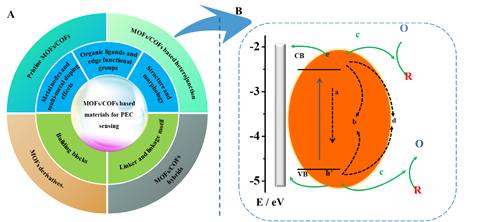Recently, the sensing and photoelectric detection research team of the Analysis and Testing Centre of the Chinese Academy of Tropical Agricultural Sciences published a research review on photoelectric chemical sensing in the international top journals in the field of analytical science. This paper systematically reviewed the design principle of PEC sensor based on MOF/COF and the key performance control factors of PEC, providing an important reference for the construction of photoelectrochemical sensing platform for hazard factors in agricultural/livestock products, and looked forward to the next development direction of PEC sensor for agricultural and veterinary drug residues.
It is reported that photoelectrochemical (PEC) sensing has the unique characteristics of low background noise, high signal to noise ratio and fast response, and is the most advanced platform for rapid and accurate monitoring of target compounds such as harmful factors in agricultural products and the environment of the origin. The sensing and photoelectric detection research team of the Analysis and Testing Centre found that metal organic frameworks (MOFs) and covalent organic frameworks (COFs) are key porous crystal materials with special application potential in PEC sensors. In recent years, they have carried out innovative work including rapid synthesis of amidoporphyrin based two-dimensional covalent organic framework materials at the liquid-liquid interface and their electrochemical applications, as well as rapid biomimetic synthesis of micellar induced Ce-MOF nanowires.
The person in charge of the sensing and photoelectric detection research team of the Test Center said that after years of research, the team recently established the Ce For MOF/silver nanowire photoelectrochemical sensing platform based on the ligand variable metal cluster charge transfer mechanism for the first time. It was found that the variable valence metal nodes can provide electronic defect states similar to those caused by polymetallic doping, and can significantly improve the photoelectric conversion efficiency in coordination with the SPR effect of AgNWs, thereby producing excellent photoelectric performance.
Based on years of research results, the team systematically reviewed the recent progress and future research trends in the field of PEC sensing based on MOF/COF, focused on discussing the design principle of photo active MOF/COF and key PEC performance control factors, and elaborated typical strategies for designing photo active MOF/COF to improve optical excitation and charge separation/transfer. The recent application progress of MOF/COF based materials (including original MOF/COFs, MOF/COF based heterostructures, MOF derivatives and MOF/COF hybrid materials) in PEC sensing is summarized. It is found that MOFs and COFs have greater structural flexibility than traditional inorganic materials, and their inherent energy band structure and electronic transport properties can be systematically adjusted by adjusting the coordination environment, organic ligands and reaction conditions. The exploration of unique advantageous materials based on MOF and COF provides broad application potential for the research of PEC sensing.

(A) Mind mapping of MOF/COF based materials applied to PEC sensing.
(B) Generation and transfer of electron holes and possible recombination paths
The achievements were published online in the international top journal Trends in Analytical Chemistry in the field of analytical science as "Recent advances in metal/covalent organic framework based materials for optoelectronic sensing applications". Ma Xionghui, an assistant researcher of the Analysis and Testing Center, is the first author of the paper, and Li Shuhuai, a young researcher, and Li Jianping, a professor of Guilin University of Technology, are the co corresponding authors. The research was supported by projects such as the basic business expenses of the central public welfare research institutes, the national banana industry technology system, and the national key laboratory of market supervision on the quality and safety of tropical fruits and vegetables.


